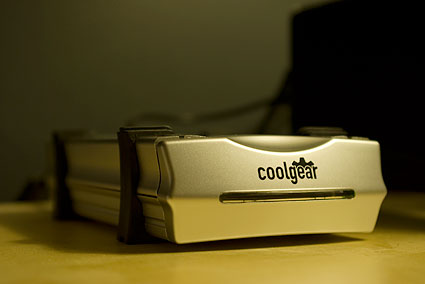
My new file storing powerhouse.
I like to keep my eye on on the price of hard disk storage. More storage more better is my philosophy. Not only can I never tell when I’ll need an extra gigabyte or two for projects, but I’m justifiably paranoid about data failure and have become something of fiend for backups as a result. So I’ve been watching with interest as the price of 500GB drives have fallen at a steady clip since the beginning of the year.
My interest was piqued recently when I noticed that a number of external 500GB drives have been hitting the ~$100 area lately, which is nearly too good a deal to pass up. My enthusiasm was tempered though, by the observation that all the drives I found were USB 2.0 only. USB is no slouch and a fine enough protocol, but real file transfers, particularly large ones, are best left to FireWire. Unfortunately, FireWire versions seem to cost $50-$90 more than their USB-only counterparts.
So I did what I’ve done for the last 5 drives I’ve purchased: I looked into do-it-yourself solutions. Assembling an external drive from an internal one plus an enclosure is a trivial task and it helps you get exactly what you want. In the past, that approach has helped me save some cash at the same time.
Unfortunately, the gap in price between internal and external drives doesn’t seem to be as great as it once was. Mail-in rebates can often bring the price of external drives to below that of internals. Realizing that I probably would be out of luck trying to save some dough, I set out to see how much I could get within the price range for an external 500GB hard drive with a FireWire connection ($160-190).
In the end, I think I did pretty well.
The first compelling drive I found was a sale at Other World Computing, whose mailing list I subscribe to: Maxtor MaXLine Pro 500 SATA II 3.0Gb “Enterprise” class drive. Faster than “consumer” drives and more ruggedly built with a five-year warranty, it looked good, real good. The $119 price tag made it look better. Though, wouldn’t you know it, the price dropped to $109 a week later.
So, with a potential drive in mind, I went searching for an enclosure. I wasn’t sure what to expect since the MaxLine series uses an SATA interface, which is certainly more prolific now than it was the last time I put together a drive two years ago. I didn’t even know if SATA to FireWire enclosures existed.
Turns out they do, but you have to know where to look. During my search, I came across a lot of sites that were scant on the technical information about their offerings, which you’d think they’d want to supply to the types of people who are building hard drives for themselves. Then I found this enclosure at CoolDrives.com, and it was better than I was expecting. It had all the specs I could hope for, plus lots of hi-res photos so I knew exactly what I would be getting: A nicely designed enclosure for either IDE or SATA drives, with e-SATA, USB 2.0 and FireWire connections on the back; just what I was looking for. On sale for $59.
A few days later, I had both my parts and quickly snapped together my new 500GB hard drive. I was extra impressed with CoolDrives when I opened the package to discover an instruction manual, a USB cable, a Firewire cable and a little screwdriver to help with assembly. Who includes tools in their shipments these days? That’s what I call service.
The performance is great. 17+MB/sec sustained transfer from FireWire to FireWire. ~28MB/sec from the internal drive to the external. (Using the USB port drops the throughput to ~11MB, so I think I’m justified in wanting FireWire). The case lacks a fan, so it’s much quieter than the dual-bay drive it replaced. It’s not silent, but the noise level is well within tolerance. The previous drive is a freakin’ wind tunnel.
I have a little cause for concern though; after spending hours copying files, the thing got hot–like bottom of a PowerBook hot–and heat is the number one enemy of hard drives. The case is compact, barely larger than the drive itself. The closed quarters and lack of fan make me wonder about how efficient the cooling of the device will be. It is made of aluminum though, which dissipates heat pretty well. The MaxLine Pro’s specs say the drive’s operating temperature is good up to 140° F (60° C), but I don’t have any way to measure it, so fingers crossed.
After all this, what did I get: With shipping, I paid $193, which is the high end of the price range. But I got a faster drive, with more options and a longer warranty than any over-the-counter solution I could find. This brand new fast, high capacity drive will hold my ever-expanding music collection approaching 16,000 songs as well as growing library of videos. It has all the connections I need now and what I might need in the future. If I ever get a Mac Pro, the SATA drive will fit internally and the case can go to either another SATA or one of my existing IDE drives.
My existing dual bay drive has become a concatenated RAID with enough storage to back up the new music drive, plus the entirety of my iMac’s Users folder. To top it off, as a result of all the data shifting, I now have a superfluous 80GB drive which I’m free to use for basic project and overflow storage as needed.
Yeah, I think I did OK.